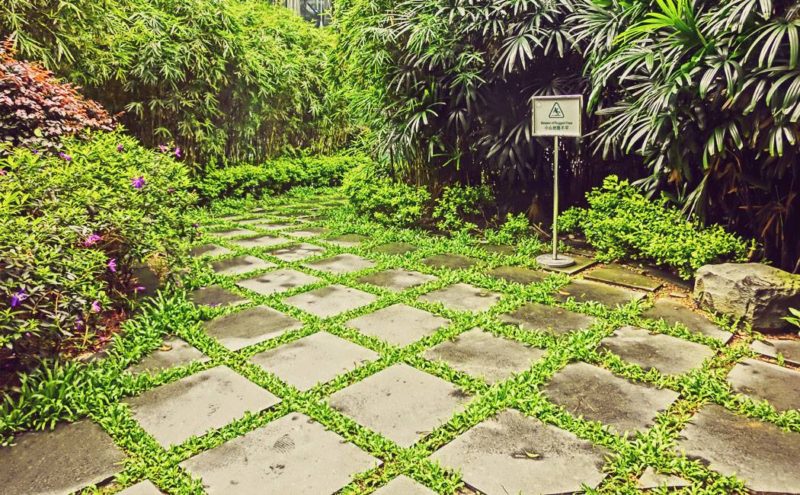We take a look at 5 rules to follow when tiling outdoor area to achieve the best results and make incredible landscape designs. Renovating the outdoor area with some beautiful tiles is a good idea to make it more interesting and eye-catching. Just like the indoor tiles, the outdoor ones are being offered in a vast majority of colors, materials and textures. However, contrary to the indoor space, tiling an outdoor area has some peculiarities that you should be aware of. In this post, we’ll go through the must-know ones.
1. Choose the Right Tiles
Probably the most significant factor when choosing the right outdoor tiles is how you plan to use the space and what weather conditions are primary in your area. These are the most popular types of outdoor tiles you can consider: Ceramic tiles. They are the best options to use indoors and, provided that they have a sufficient PEI rating, can be used outdoors as well. If you decided to use ceramic tiles outdoors, do not glaze them as this would make the surface slippery when it’s damp outside. Porcelain tiles. Being much stronger and less prone to water absorption, these tiles make a better choice for the outdoor areas. Many come with a non-slippery texture. Quarry tiles. Coming in a very limited color range, these tiles are thick and dense. Home owners love them as they add a nice touch of Mediterranean design. Sandstone tiles. This is a great solution for patios. Remember, however, that they need to be properly sealed in order not to absorb water. Granite tiles. Of course, this type makes the most durable tiles. It doesn’t absorb water and salt and you don’t have to seal the tiles. Limestone tiles. These tiles are beautiful and strong and are a great choice for outdoors. The only drawback is they can easily be ruined by acids (both natural and acidic detergents) so be sure to seal the surface. Travertine tiles. This is a type of the limestone tiles which is famous for its spongy look. Just like the limestone, travertine tiles are very strong and durable but subject to the negative impact of acids. For this reason, make sure to seal the tiles. Soapstone tiles. These tiles make an exquisite choice for the outdoor area, even while being quite soft and, therefore, subject to scratches. You can fix the scratches with a mineral oil textures. Slate tiles. These tiles have a unique uneven surface which gives them a natural air. If you live in a warm region, you can safely install them outdoors. In colder climates, these tiles can crack. Outdoor rubber tiles. While not having that beautiful natural look, this type of tiles is great in terms of safety. It’s non-slippery and, coming in a vast array of colors and patterns, can be a perfect match for many homes. Outdoor deck tiles. If you’re a fan of DIY home renovations, these tiles will come in handy. You don’t even have to buy nails or adhesives. Just place them on the outdoor area and that’s it. Outdoor carpet tiles. Basically, these are square carpet pieces. You can easily remove, replace and clean them. They are non-slippery and could be installed in any outdoor area.
2. Consider your climate
The climate you live in greatly impacts your choice of outdoor tiles. Warm climates allow for softer tiles, while colder regions call for tough, strong tiles. You wouldn’t like your brand new tiles to crack all over once the temperature falls to -2°, right? Before purchasing anything, consult a seller with regards to the weather conditions you live in. Don’t go for cheaper options – installing inappropriate tiles can not only turn out to be costly but dangerous to your health too.
3. Prepare the area carefully
It’s especially important to carefully check your outdoor area for any cracks, hidden valleys, etc. The surface should be smooth and even, otherwise the tiling process is going to be difficult, if not impossible. The area should be even enough to tile it.
4. Check proximity
Depending on the material and climate, the tiles can behave differently than you might expect. Sometimes factors such as sunlight or excessive moisture can cause the tiles to contract or expand. It’s a good idea to keep an eye on things after you installed the tiles.
5. Seal the tiles
In most cases, it’s recommended that you seal the tiles with a proper solution (depending on the tiles you used). That’s because the outdoor tiles are naturally exposed to a much stronger climate impact than indoor tiles. For this reason, you’d want to provide them with an extra layer of security. These practical tips will guide you through the process of buying and installing the tiles for your outdoor area.
Recommended Reading:
- Becoming an Urban Planner: A Guide to Careers in Planning and Urban Design by Michael Bayer
- Sustainable Urbanism: Urban Design With Nature by Douglas Farrs
Article by Oleg Yemchuk Featured Image: By Eowkdfnd – Own work, CC BY-SA 3.0, source
Published in Blog









